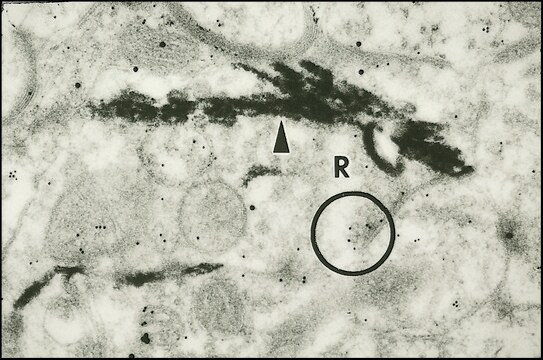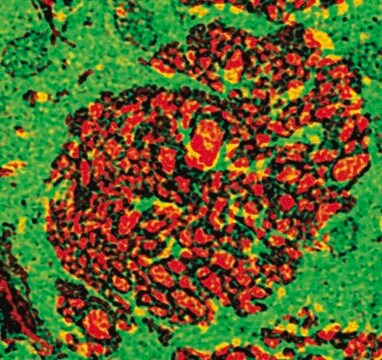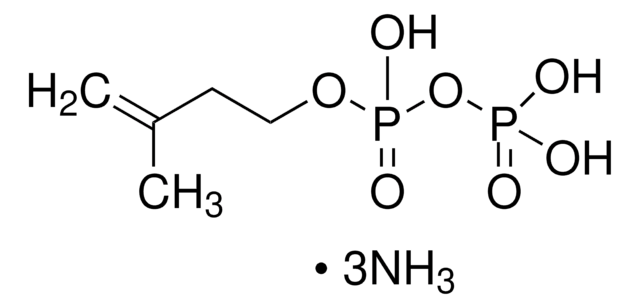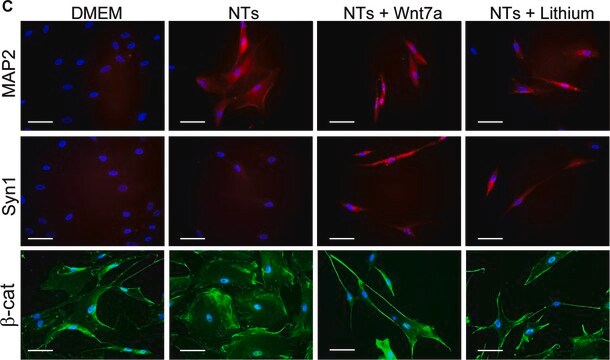G9282
Monoclonal Anti-Glutamate antibody produced in mouse
clone GLU-4, ascites fluid
Faça loginpara ver os preços organizacionais e de contrato
About This Item
Produtos recomendados
fonte biológica
mouse
Nível de qualidade
conjugado
unconjugated
forma do anticorpo
ascites fluid
tipo de produto de anticorpo
primary antibodies
clone
GLU-4, monoclonal
contém
15 mM sodium azide
reatividade de espécies
wide range
técnica(s)
indirect ELISA: 1:10,000 using in situ prepared L-glutamate-glutaraldehyde-BSA conjugate for coating
Isotipo
IgG1
Condições de expedição
dry ice
temperatura de armazenamento
−20°C
modificação pós-traducional do alvo
unmodified
Informações sobre genes
human ... GRM1(2911)
Categorias relacionadas
Especificidade
The antibody reacts specifically with L-glutamate (L-glutamic acid), when immobilized with glutaraldehyde. Cross-reaction is observed with Gly-Glu and Asp-Glu. When using the product at the recommended working dilution, in indirect and competitive ELISA, weak cross-reaction may be obtained with D-glutamate, L-glutamine, L-aspartate, D-aspartate, L-asparagine, β-alanine, glycine, 5-aminovaleric acid, γ-aminobutyric acid (GABA) and Gly-Asp. Glutamate is found in cell bodies, axons, and terminals of glutamatergic neurons in the CNS.
Imunogênio
L-glutamic acid (Glu).
Aplicação
Applications in which this antibody has been used successfully, and the associated peer-reviewed papers, are given below.
Immuno-electron microscopy (1 paper)
Immuno-electron microscopy (1 paper)
Monoclonal Anti-Glutamate antibody produced in mouse is suitable for:
- immunolabeling of glutamate in the lamina of the Drosophila visual system
- immunocytochemistry at a working dilution of 1:20,000 to detect glutamate using heart and extrinsic nerves of stomatopod crustacean, Squilla oratoria
- immunofluorescent staining as a primary antibody at a working dilution of 1:1000 using cryosections of brains and embryos from mice
- use as a primary antibody to measure the glutamate release in synaptosome preparations
Ações bioquímicas/fisiológicas
Glutamate is an amino acid that acts as a excitatory neurotransmitter in the vertebrate brain and functions in all brain processes. It is released from one end of the neuron and it binds to receptors on the surface of adjacent neurons. Glutamate is released in a calcium-dependent manner in response to depolarizing stimuli. It serves as a substrate in certain metabolic pathways, such as, synthesis of glutamine and γ-aminobutyric acid (GABA) Excessive release of glutamate or aspartate have been observed in the pathogenesis of certain neurodegenerative diseases, such as, Huntington′s disease, Alzheimer′s disease. The same is also observed in selective neuronal degenerations involved in epilepsy, ischemia, and hypoglycemia.
Exoneração de responsabilidade
Unless otherwise stated in our catalog or other company documentation accompanying the product(s), our products are intended for research use only and are not to be used for any other purpose, which includes but is not limited to, unauthorized commercial uses, in vitro diagnostic uses, ex vivo or in vivo therapeutic uses or any type of consumption or application to humans or animals.
Não está encontrando o produto certo?
Experimente o nosso Ferramenta de seleção de produtos.
Código de classe de armazenamento
10 - Combustible liquids
Classe de risco de água (WGK)
WGK 3
Ponto de fulgor (°F)
Not applicable
Ponto de fulgor (°C)
Not applicable
Escolha uma das versões mais recentes:
Já possui este produto?
Encontre a documentação dos produtos que você adquiriu recentemente na biblioteca de documentos.
Hiroshi Ando et al.
The Journal of experimental biology, 207(Pt 26), 4663-4677 (2004-12-08)
The heart of Squilla oratoria contains a cardiac ganglion that consists of 15 intrinsic neurons, supplied by a pair of inhibitory nerves and two pairs of excitatory nerves, arising from the central nervous system. These comprise the extrinsic cardiac innervation.
Petrusz P, et al.
Techniques in Immunocytochemistry, 4, 253-253 (1989)
Ling-Qiang Zhu et al.
The Journal of neuroscience : the official journal of the Society for Neuroscience, 27(45), 12211-12220 (2007-11-09)
Activation of glycogen synthase kinase-3 (GSK-3) can cause memory deficits as seen in Alzheimer's disease, the most common age-associated dementia, but the mechanism is not understood. Here, we found that activation of GSK-3 by wortmannin or transient overexpression of wild-type
A lot of "excitement' about neurodegeneration.
R Taylor
Science (New York, N.Y.), 252(5011), 1380-1381 (1991-06-07)
Yun Zhang et al.
The journal of headache and pain, 21(1), 72-72 (2020-06-12)
Vestibular migraine has recently been recognized as a novel subtype of migraine. However, the mechanism that relate vestibular symptoms to migraine had not been well elucidated. Thus, the present study investigated vestibular dysfunction in a rat model of chronic migraine
Nossa equipe de cientistas tem experiência em todas as áreas de pesquisa, incluindo Life Sciences, ciência de materiais, síntese química, cromatografia, química analítica e muitas outras.
Entre em contato com a assistência técnica







